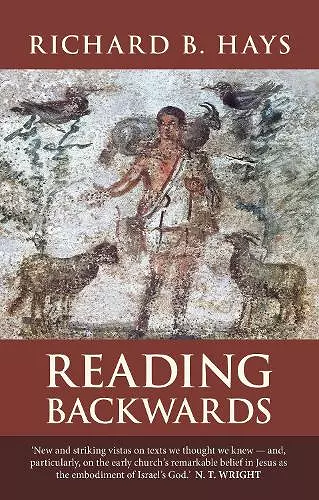Reading Backwards
Format:Paperback
Publisher:SPCK Publishing
Published:21st May '15
Currently unavailable, and unfortunately no date known when it will be back

An investigation into how the four Gospel writers drew on the Old Testament to demonstrate their belief that Jesus was nothing less than the embodiment of Israel’s God.
The claim that the events of Jesus' life, death, and resurrection took place ‘according to the Scriptures’ stands at the heart of the New Testament's earliest message. All four canonical Gospels declare that the Torah, Prophets and Psalms mysteriously prefigure Jesus. In this ground-breaking new book, Hays traces the strategies the Gospel writers employ to ‘read backwards’, showing how the Old Testament figuratively discloses the astonishing truth about Jesus' identity.
· ‘Hays opens new and striking vistas on texts we thought we knew—and, particularly, on the early church’s remarkable belief in Jesus as the embodiment of Israel’s God.’ -- N. T. Wright
You might have seen Richard Hays’ Reading Backwards: Figural Christology and the Fourfold Gospel Witness with a different cover. Originally published by Baylor University Press, there is now a paperback edition courtesy of SPCK and they graciously sent me a copy. I hadn’t read any of Hays’ works, but I see his name frequently and N. T. Wright did dedicate PFG to him. Sometimes I get bored with regular reading so the opportunity to learn a new skill intrigued me. The book itself is derived from a series of lectures Hays delivered at Cambridge in 2013 and 2014. It is a preview of a Gospel focused sequel he is working on toEchoes of Scripture in the Letters of Paul. In his preface, Hays mentions several forerunners to the type of work he is doing (Dodd, Wright, Hurtado, Bauckham, to name a few). He then offers an introductory chapter on figural reading, which as you might have figured, is the backwards reading the title refers to. There then follows a short chapter on each Gospel writer’s strategy of doing this. The final chapter offers summary thoughts on retrospective readings and the challenge and benefit of Gospel-shaped hermeneutics. If you leave out the front and back matter, the body of this book (chapters 1-6) is just over 100 pages. As such, it is quick read but a slow digest on reading the Old Testament in light of Christ. It is thought provoking and nowhere near a final word on the method of reading this way. After reading it, I’d like to go back and dig into some of Hays other works and I’ll look forward to the full length title that this book previews. Richard B Hays, Reading Backwards: Figural Christology and the Fourfold Gospel Witness. London: SPCK, May 2015. 155 + xxii pp. Paperback, $26.73. Buy it: Amazon Visit the publisher’s page Thanks to SPCK for the review copy! -- Nathaniel Claiborne * http://nathanielclaiborne.com/ *
After Hays’s enormously influential book, Echoes of Scripture in the Letters of Paul (1989), readers have eagerly anticipated a companion volume on the Gospels. This is not it, as Hays says in the Introduction, but it is offered as an interim statement until time permits a fuller study. The book has an introduction, where the concept of ‘figural reading’ or ‘reading backwards’ is expounded, a chapter on each of the canonical Gospels, and a concluding reflection which sums up the thesis of the book, ‘Retrospective Reading: The Challenges of Gospel-Shaped Hermeneutics’. Historical-critical scholars have long pointed out that the New Testament authors interpreted the Scriptures in the light of their Christian beliefs and criticized them for doing so. Conservative scholars responded by trying to show that such beliefs were at least implicit in the ancient texts (‘latent’ is becoming a popular word). Hays, however, accepts the point but denies the criticism, stating that ‘in light of the unfolding story of Jesus, it is both right and illuminating to read backwards and to discover in the Law and the Prophets an unexpected foreshadowing of the later story’ (p. 94). The problem with historical-critical scholarship is that, once an element of dissonance has been discerned, it fails to dig deeper. Hays attempts to correct this by offering fresh readings of the Gospels, where careful attention to echoes and allusions not only brings new insights but also challenges a number of critical consensuses. For example, Mark is said to have a ‘low’ Christology but Hays argues that the text invites readers to search the Scriptures to answer such questions as: ‘Who is the Kyrios?’ (1.2–3); ‘Who can forgive sins but God alone?’ (2.7); ‘Who is the shepherd of Israel?’ (6.34); ‘Who walks on the sea?’ (6.45–52). The answer in each case is Israel’s God, and so while it is true that Mark is not as explicit about Jesus’ divinity as John’s Gospel he is ‘hinting that Jesus is the mysteriously embodied presence of Israel’s God’ (p. 26). Hays does not wish to neglect the many features of Mark that could imply ‘Jesus non-identity with God’ (p. 27) and concludes that we are ‘drawn into the contemplation of a paradoxical revelation that shatters our categories and exceeds our understanding’ (p. 32). He is less comfortable with Matthew since his editorial proof-texts are precisely what he wishes to challenge but he does seek to show that there are riches to discover if the wider context of the citations is explored. As one has come to expect from Hays’s writings, the book is a joy to read and will prompt much discussion. For example, on what basis are echoes and allusions of ‘divine identity’ (he records his debt to Bauckham here) given greater weight than explicit quotations that identify Jesus with the ‘anointed prophet’ (Luke 4.16–21) or ‘servant of God’ (Matt. 12.17–21)? Can Job 9.8, which poetically describes God as the one who ‘trampled the waves of the sea’ really be the key to understanding Mark’s ‘walking on the water’ episode? -- Steve Moyise * Theology journal *
ISBN: 9780281074082
Dimensions: unknown
Weight: 237g
180 pages